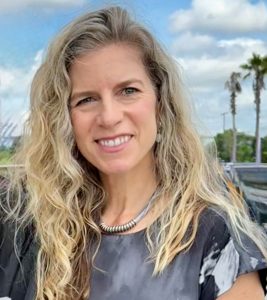 Multi-award winning IRO, Deborah Belevan, IRC, CPA, joined Duolingo in 2021 as VP, IR, two weeks before the IPO. Since then, Duolingo has seen exponential growth in both its share price and subscriber base. Debbie is an active NIRI Board Member.
Multi-award winning IRO, Deborah Belevan, IRC, CPA, joined Duolingo in 2021 as VP, IR, two weeks before the IPO. Since then, Duolingo has seen exponential growth in both its share price and subscriber base. Debbie is an active NIRI Board Member.
In April 2025, Debbie and Duolingo swept the IR Impact Awards’ board – Best Overall IR – Midcap, Best IR – Technology and Best IR Officer – Midcap.
Duolingo launched in 2012 and has since become the leading mobile learning platform globally. The app has organically become the world’s most popular way to learn languages and the top-grossing app in the Education category on both Google Play and the Apple App Store. Since its IPO, Nasdaq-listed Duolingo’s market cap has risen from $6.5 billion to over $15 billion today.
While Duolingo wasn’t your first IPO, it must have been a baptism of fire, joining two weeks beforehand?
Joining the company at such a pivotal moment was the perfect opportunity to get up to speed on our history, products, and culture – directly from our co-founder, Luis – and to hear firsthand the types of questions investors had. It was very clear from the start that there’s a strong sense of mission in everything we do.
Fortunately, in 2021, the roadshow was entirely virtual, which meant I could juggle IPO meetings alongside our internal “Nuoversity” onboarding sessions. It was a busy first week to say the least.
Another positive, Duolingo was already a very beloved brand with compelling growth so I was excited to be stepping into a role where my responsibility was to articulate that in a way the investment community could appreciate.
Discuss the changes you’ve seen at Duolingo since the IPO.
First of all, going public brings a new level of discipline for any company because now you’re accountable for your strategy, your forecasts and your execution.
We’ve grown a lot in terms of scale, internal sophistication, global reach and in our ambitions, expanding beyond language learning now to other subjects. So, we’ve evolved from being language focused to a broader learning platform.
We’ve matured as a public company – refining our investment thesis, developing new investor communications, and building out a cadence that includes a quarterly Zoom call and a shareholder letter.
Despite the growth, what hasn’t changed is the creativity, or the intense focus on building a genuinely great product. Our increased market cap means that we are now on the radar of larger investors. While the number of passive investors has increased due to our inclusion in a number of indices, which increases volatility, we’ve got a great roster of loyal shareholders. Many of our IPO investors are still our top holders, which speaks to the strength of the long-term story. We are proactive and have recently hosted more targeted outreach like we did with Phoenix Investor Relations in Europe, and we now tailor our message to different types of investors.
Any common investor concerns?
The durability of our growth and how much of the TAM we can capture. As a freemium model, a lot of learners don’t pay, so today over 90% of our monthly active users are learning completely for free. People want to understand how are we going to monetize more people? Our mission is to make high-quality education universally available. And by investing in the free user experience, we grow the funnel for paid users. It’s a long-term strategy.
Some investors ask about competition, but we have a strong brand and deep engagement. Our data model is hard to replicate. So, once people get to know us, they realise there’s little in the language learning space that compares to Duolingo.
How have you improved your ESG score since the IPO?
At IPO, we just didn’t have the disclosures in place. Our team felt the mission alone, free global education, was a compelling ESG story in itself. Our scores were mediocre because we weren’t getting credit for things we were doing, like data privacy and taking care of our employees, which obviously we do.
ESG investors loved the company, loved the story but were limited to how much they could invest unless we improved our scores. So, we started, putting out a corporate responsibility report and an impact fact sheet and our scores have improved significantly.
How do you convince investors that Duolingo is worth its premium valuation?
It’s not our job to justify our valuation. Investors are best equipped to make that call. We focus on telling the story as clearly and transparently as possible. We emphasize how we’re positioned to grow for many years and how the product and strategy support that trajectory.
Our goal is to help investors understand the drivers of our business so we can achieve fair value for our equity over time.
How does working for a consumer company differ?
It’s a completely different culture in the best way. First of all, the product is widely used, so we don’t need to explain what we do or who our user is – they are the user.
I love when investors start a meeting by showing me their streak. There’s an immediate connection and they want to give their personal feedback and experience. So that’s amazing. Also, as a tech company, we’ve got incredible tools that help us do our jobs more efficiently.
Your co-founder Luis is still very much involved?
Luis is incredibly hands on. He’s deeply passionate about the product and attends all product review meetings. Also, he’s heavily involved in the strategic decisions. Despite his success, he’s incredibly humble, very team oriented, and very kind.
From an IR standpoint, it’s really a gift having your investors hear directly from the visionary behind the company. His academic background and long term thinking really resonate with our investors. He’s very candid about what’s working in the business and the areas we still have to improve.
Duolingo seems to have a fun culture, discuss.
Our culture starts with our mission, but we also have a strong sense of playfulness
and it’s a fun place to work. We have 5 operating principles that shape our culture and my favorite, is ‘Make it Fun’. This playfulness even shows up in investor decks and earnings calls and that’s intentional. We have incredible people, but we’re all a bit quirky.
Best thing about working at Duolingo?
Apart from the fun culture, working on something that millions of people love and benefit from. The type of people we hire (we have a very high bar!). We want people who are very smart but also no egos.
We have industry leading low staff turnover and that’s because it’s just a great place to work. Being part of something that millions of people love and benefit from is pretty special.
Any challenges?
Creatively, analytically, culturally, you’re expected to perform. It’s a very demanding job.
You won three awards at the recent IR Impact Awards – Best Overall IR – Midcap, Best IR – Tech and Best IR Officer – Midcap, discuss?
That was an amazing night. I did not expect to win one, let alone three awards.
Those awards are based on investor feedback, so they were really a testament to how well we’re telling the story and executing the program. But it was 100% a team win.
You’re a NIRI board member with a wealth of experience, how do you share your knowledge?
I love being part of NIRI. It’s a collaborative community and a great platform to support the next generation of IR professionals. I love helping support others and find it really rewarding sharing my experience and passion with younger IR professionals.
IR wasn’t well known when I started – I stumbled into it from a financial reporting role in a gold mining company and quickly realized it was the coolest job in the company. From speaking to the C-suite to geologists and getting to know the company inside out.
Advice?
Always be curious, ask questions and don’t be afraid to reach out – whether to executives inside your company or investors on the outside. IR is about relationships, and relationships start with genuine interest.”
Anything you’d change?
Not a thing.
By Gill Newton, partner at Phoenix-IR. This interview also appeared in IR Impact on September 3, 2025.
Get in touch if you’d like to feature in our next “A Day in the Life of an IRO”.
Nobody knows the European investment community better than Phoenix-IR.


 Automatic Data Processing (ADP) is a $97 bn human resources management software company listed on Nasdaq. Danyal Hussain joined the firm in 2018 as senior director of IR, becoming vice president and head of IR in February 2020.
Automatic Data Processing (ADP) is a $97 bn human resources management software company listed on Nasdaq. Danyal Hussain joined the firm in 2018 as senior director of IR, becoming vice president and head of IR in February 2020. John Renwick, VP of Investor Relations & Corporate Planning at Kellanova (formerly Kellogg) has spent 23 years at the company. He initially joined in 2000 as VP of IR & Competitive Analysis and then held a number of operational roles in – Kuala Lumpur, Malaysia, Toronto, Canada, Queretaro Area, Mexico before returning to Battle Creek, MI and reprising and expanding his role as VP of IR & Corporate Planning in 2016.
John Renwick, VP of Investor Relations & Corporate Planning at Kellanova (formerly Kellogg) has spent 23 years at the company. He initially joined in 2000 as VP of IR & Competitive Analysis and then held a number of operational roles in – Kuala Lumpur, Malaysia, Toronto, Canada, Queretaro Area, Mexico before returning to Battle Creek, MI and reprising and expanding his role as VP of IR & Corporate Planning in 2016.